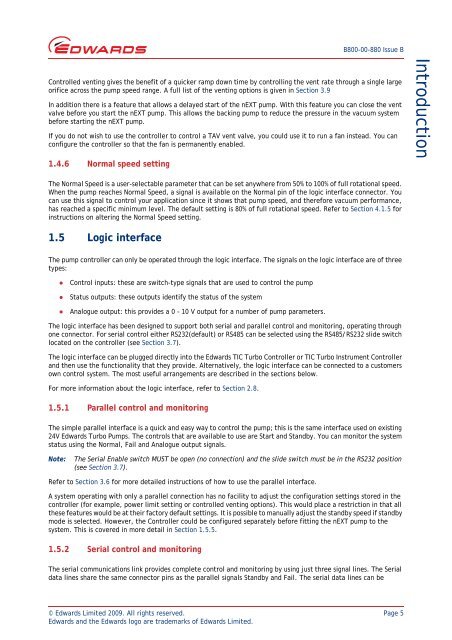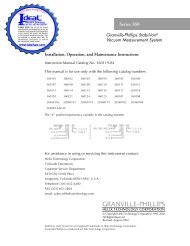Edwards, nEXT Turbomolecular Pumps, nEXT240, nEXT300 and ...
Edwards, nEXT Turbomolecular Pumps, nEXT240, nEXT300 and ...
Edwards, nEXT Turbomolecular Pumps, nEXT240, nEXT300 and ...
You also want an ePaper? Increase the reach of your titles
YUMPU automatically turns print PDFs into web optimized ePapers that Google loves.
B800-00-880 Issue B<br />
Controlled venting gives the benefit of a quicker ramp down time by controlling the vent rate through a single large<br />
orifice across the pump speed range. A full list of the venting options is given in Section 3.9<br />
In addition there is a feature that allows a delayed start of the <strong>nEXT</strong> pump. With this feature you can close the vent<br />
valve before you start the <strong>nEXT</strong> pump. This allows the backing pump to reduce the pressure in the vacuum system<br />
before starting the <strong>nEXT</strong> pump.<br />
If you do not wish to use the controller to control a TAV vent valve, you could use it to run a fan instead. You can<br />
configure the controller so that the fan is permanently enabled.<br />
1.4.6 Normal speed setting<br />
Introduction<br />
The Normal Speed is a user-selectable parameter that can be set anywhere from 50% to 100% of full rotational speed.<br />
When the pump reaches Normal Speed, a signal is available on the Normal pin of the logic interface connector. You<br />
can use this signal to control your application since it shows that pump speed, <strong>and</strong> therefore vacuum performance,<br />
has reached a specific minimum level. The default setting is 80% of full rotational speed. Refer to Section 4.1.5 for<br />
instructions on altering the Normal Speed setting.<br />
1.5 Logic interface<br />
The pump controller can only be operated through the logic interface. The signals on the logic interface are of three<br />
types:<br />
• Control inputs: these are switch-type signals that are used to control the pump<br />
• Status outputs: these outputs identify the status of the system<br />
• Analogue output: this provides a 0 – 10 V output for a number of pump parameters.<br />
The logic interface has been designed to support both serial <strong>and</strong> parallel control <strong>and</strong> monitoring, operating through<br />
one connector. For serial control either RS232(default) or RS485 can be selected using the RS485/RS232 slide switch<br />
located on the controller (see Section 3.7).<br />
The logic interface can be plugged directly into the <strong>Edwards</strong> TIC Turbo Controller or TIC Turbo Instrument Controller<br />
<strong>and</strong> then use the functionality that they provide. Alternatively, the logic interface can be connected to a customers<br />
own control system. The most useful arrangements are described in the sections below.<br />
For more information about the logic interface, refer to Section 2.8.<br />
1.5.1 Parallel control <strong>and</strong> monitoring<br />
The simple parallel interface is a quick <strong>and</strong> easy way to control the pump; this is the same interface used on existing<br />
24V <strong>Edwards</strong> Turbo <strong>Pumps</strong>. The controls that are available to use are Start <strong>and</strong> St<strong>and</strong>by. You can monitor the system<br />
status using the Normal, Fail <strong>and</strong> Analogue output signals.<br />
Note:<br />
The Serial Enable switch MUST be open (no connection) <strong>and</strong> the slide switch must be in the RS232 position<br />
(see Section 3.7).<br />
Refer to Section 3.6 for more detailed instructions of how to use the parallel interface.<br />
A system operating with only a parallel connection has no facility to adjust the configuration settings stored in the<br />
controller (for example, power limit setting or controlled venting options). This would place a restriction in that all<br />
these features would be at their factory default settings. It is possible to manually adjust the st<strong>and</strong>by speed if st<strong>and</strong>by<br />
mode is selected. However, the Controller could be configured separately before fitting the <strong>nEXT</strong> pump to the<br />
system. This is covered in more detail in Section 1.5.5.<br />
1.5.2 Serial control <strong>and</strong> monitoring<br />
The serial communications link provides complete control <strong>and</strong> monitoring by using just three signal lines. The Serial<br />
data lines share the same connector pins as the parallel signals St<strong>and</strong>by <strong>and</strong> Fail. The serial data lines can be<br />
© <strong>Edwards</strong> Limited 2009. All rights reserved. Page 5<br />
<strong>Edwards</strong> <strong>and</strong> the <strong>Edwards</strong> logo are trademarks of <strong>Edwards</strong> Limited.
















